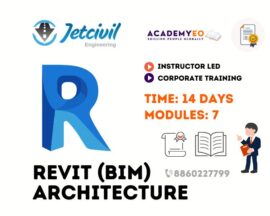Etabs Building Analysis & Design Course
₹ 7,999.00
- 14 Days (1 hr/day) Course
- Indian Instructor Led
- Language: Hindi/English
- Notes & e-PDFs
- Mini Project
- Hard copy Certificate
![]()
- Description
- Additional information
Description
Course Outline: Learn Etabs as Structural Software for Building Analysis and Design Online via Instructor Led Program. In this course you can learn about design of steel and concrete frames (with automated optimization), composite beams, composite columns, steel joists, and concrete and masonry shear walls is included, as is the capacity check for steel connections and base plates and schematic construction drawings of framing plans, schedules, details, and cross-sections may be generated for concrete and steel structures. (Note: We care for your schedule and so in this course a trainer will be assigned to the student enrolled and course will start as per student convenient date and timing).
Features and Benefits of ETABS
- The input, output and numerical solution techniques of ETABS are specifically designed to take advantage of the unique physical and numerical characteristics associated with building type structures. As a result, this analysis and design tool expedites data preparation, output interpretation and execution throughput.
- The need for special purpose programmes has never been more evident as Structural Engineers put non-linear dynamic analysis into practice and use the greater computer power available today to create larger analytical models.
- Over the past two decades, ETABS has numerous mega-projects to its credit and has established itself as the standard of the industry. ETABS software is clearly recognised as the most practical and efficient tool for the static and dynamic analysis of multistorey frame and shear wall buildings. Above Text Source: Quora
Advantages:
- 3D axonometric view of the model, plan view, elevation view, elevation development view, custom view defined by the user
- Graphic input of cross sections of any geometry and material (Section Designer)
- Copy and Paste of the geometry of a model to and from spreadsheets
- Export of the model geometry to .dxf files
- Integration with EC – Praxis 3J for the analysis and design of steel connections
Learn ETABS as it provides an unequaled suite of tools for structural engineers designing buildings, whether they are working on one-story industrial structures or the tallest commercial high-rises.
Modeling of Structural Systems
- Templates for global-system and local-element modeling
- Customized section geometry and constitutive behavior
- Grouping of frame and shell objects
- Link assignment for modeling isolators, dampers, and other advanced seismic systems
- Nonlinear hinge specification
- Automatic meshing with manual options
- Editing and assignment features for plan, elevation, and 3D view
- Once modeling is complete, ETABS automatically generates and assigns code-based loading conditions for gravity, seismic, wind, and thermal forces. Users may specify an unlimited number of load cases and combinations.
- Analysis capabilities then offer advanced nonlinear methods for characterization of static-pushover and dynamic response. Dynamic considerations may include modal, response-spectrum, or time-history analysis. P-delta effect account for geometric nonlinearity.
- Given enveloping specification, design features will automatically size elements and systems, design reinforcing schemes, and otherwise optimize the structure according to desired performance measures.
Output, Interoperability, and Versatility
- Output and display formats are also practical and intuitive. Moment, shear, and axial force diagrams, presented in 2D and 3D views with corresponding data sets, may be organized into customizable reports. Also available are detailed section cuts depicting various local response measures. Global perspectives depicting static displaced configurations or video animations of time-history response are available as well.
- Learn Etabs which also features interoperability with related software products, providing for the import of architectural models from various technical drawing software, or export to various platforms and file formats. SAFE, the floor and foundation slab design software with post-tensioning (PT) capability, is one such option for export. CSI coordinated SAFE to be used in conjunction with ETABS such that engineers could more thoroughly detail, analyze, and design the individual levels of an ETABS model.
- While ETABS features a variety of sophisticated capabilities, the software is equally useful for designing basic systems. ETABS is the practical choice for all grid-like applications ranging from simple 2D frames to the most complex high rises.
Additional information
| Enrollment for | Individual, Institutional |
|---|

















